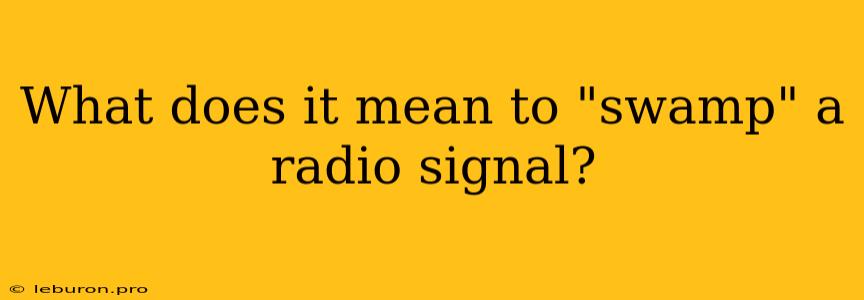In the realm of radio communication, the term "swamping" refers to a phenomenon where a strong signal overwhelms a weaker one, rendering the weaker signal essentially unusable. This can occur in various scenarios, from everyday radio interference to intentional jamming techniques used in warfare or security contexts. Understanding the mechanics of signal swamping is crucial for ensuring reliable communication, especially in environments where competing signals are present.
The Essence of Signal Swamping
Imagine two people trying to talk to each other amidst a noisy crowd. If one person speaks softly while the other shouts loudly, the softer voice will be drowned out. This analogy aptly illustrates the concept of signal swamping. In the context of radio communication, a strong signal can "swamp" a weaker one when both signals occupy the same frequency band or share a similar spectral region.
How Signal Swamping Occurs
Signal swamping is primarily governed by the power levels of the competing signals. The stronger signal, with its higher power output, dominates the receiver's antenna, effectively blocking the weaker signal from being detected. This dominance can be attributed to various factors, including:
- Transmitter Power: A powerful transmitter naturally has a higher signal strength, making it more likely to swamp weaker signals.
- Antenna Gain: Antennas with higher gain can focus and amplify a signal, further enhancing its ability to overcome weaker signals.
- Distance: Signals weaken as they travel through space. A strong signal originating close to a receiver is more likely to swamp a weaker signal coming from a distant source.
- Frequency Overlap: If two signals share the same frequency or operate in adjacent frequency bands, the stronger signal can interfere with the weaker one.
Implications of Signal Swamping
Signal swamping can have significant repercussions for radio communication, impacting various aspects:
- Data Transmission: In data communication, a swamped signal can lead to errors, corrupted data, or complete data loss.
- Voice Communication: Swamping can cause voice communication to become unintelligible, characterized by garbled audio, dropouts, or complete loss of the weaker signal.
- Interference: Swamping can create interference in other radio systems operating nearby, disrupting their operation and potentially causing unwanted noise.
- Security: In military and security contexts, signal swamping can be employed as a jamming technique to disrupt enemy communication or prevent the detection of friendly signals.
Mitigating Signal Swamping
Several strategies can be employed to minimize the effects of signal swamping:
- Frequency Allocation: Proper frequency allocation ensures that different communication systems operate on different frequencies, reducing the likelihood of interference.
- Power Control: Adjusting transmitter power levels can help balance the signal strength and prevent weaker signals from being swamped.
- Directional Antennas: Using highly directional antennas can focus the signal towards the intended receiver, minimizing the impact of competing signals.
- Signal Processing Techniques: Advanced signal processing techniques can be used to filter out interfering signals and isolate the desired signal.
- Spread Spectrum Techniques: Spread spectrum technologies can spread the signal over a wider frequency band, making it less vulnerable to narrowband interference.
Conclusion
Signal swamping, a phenomenon rooted in the principle of signal strength dominance, poses a significant challenge for reliable radio communication. Understanding its causes, consequences, and mitigation techniques is crucial for ensuring robust communication systems. From everyday radio interference to sophisticated jamming tactics, the ability to overcome signal swamping is vital for both civilian and military applications.
